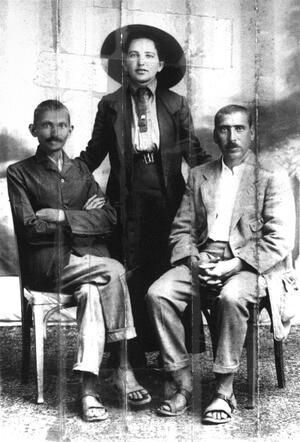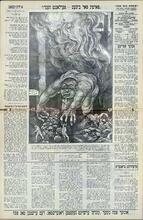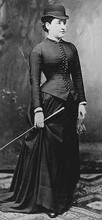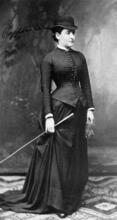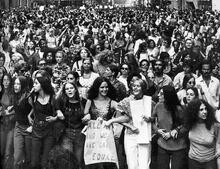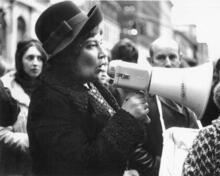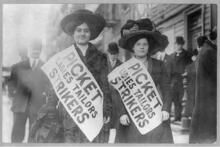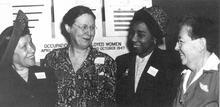Sonja Schlesin
Sonja Schlesin was eighteen when the young lawyer Mohandas Gandhi hired her in 1906 as the secretary for his Johannesburg office. She gradually rose to become one of his most trusted associates during his last eight turbulent years in South Africa. Schlesin spoke out against racism, taught and mentored young people, kept track of correspondence and financial matters at Gandhi’s busy office, and took an active role in the huge nonviolent protest marches of 1913. Despite Gandhi’s pleas that she come to India to assist him, she remained in South Africa and led a quiet life as a high school Latin teacher after those eight extraordinary years.
Connecting With Gandhi
Sonja Schlesin was born on June 6, 1888, in Moscow to Yiddish-speaking Lithuanian Jews Isidor and Dorothy (Rosenberg) Schlesin. Probably because of an expulsion of Jews from Russian cities in 1891, her parents emigrated and arrived in Cape Town, South Africa, in l892, and settled in Johannesburg. Sonia Schlesin received her school-leaving certificate in 1903 through examinations administered by the University of the Cape of Good Hope.
Schlesin came into Mahatma Gandhi’s orbit unexpectedly when she was only eighteen, when he was looking for a new secretary for his busy law office in Johannesburg, South Africa. One of his close associates, the Jewish architect Hermann Kallenbach, knew of Schlesin because he and her uncle were from the same small town in Russia, and he recommended her for the position. When Gandhi discovered that she was extremely fast at shorthand, he hired her.
From that moment in 1906, Schlesin’s life took an entirely different course. She became intimately involved in Gandhi’s efforts on behalf of the immigrant Indian population, and he soon realized that she had a range of talents and capabilities and encouraged her to take on more and more responsibilities.
Wide Responsibilities
Schlesin arrived in Gandhi’s circle as he was reaching the top of his extraordinary rise within South Africa’s growing Indian immigrant community. After arriving in 1893 as a young British-trained lawyer to defend several Indian clients who had engaged his services, he took on broader battles and fought in court, first in the British province of Natal and later in the Boer-dominated Transvaal, as whites in both provinces emphatically rejected “Asiatics” as potential citizens and sought to limit immigration and restrict movement. Although Britons and Boers had fought each other in the brutal Boer war of 1899-1902, after the war they united to repress immigrant Indians and Chinese and to rule severely over the Black native population.
Gandhi soon came to depend on Sonja Schlesin for all kinds of help. For eight years—from the time she was eighteen until she was 26, when Gandhi returned to India—she was immersed in his circle and made exceptional contributions to his efforts. While several Jewish men (Henry Polak, Hermann Kallenbach, and Louis W. Ritch) were among Gandhi’s closest South African supporters and associates, Sonja Schlesin was the only Jewish woman.
Schlesin was quite visible from the start as Gandhi’s secretary, a young, short-haired white woman at her desk in the waiting room of his law office, which was often crowded with Indians beseeching him for help. She dealt with Gandhi’s correspondence and handled financial matters when he was away for extended periods.
At Phoenix, the communal experimental school and farm near Durban that Gandhi founded in 1904, Schlesin taught and mentored young people and took them on excursions. Gandhi’s great-nephew Prabhudas Gandhi, who came to know her at Phoenix when he was twelve, remembered her as exceptionally courageous and intelligent, and also full of fun. Besides these responsibilities, in 1909 she was asked to serve as secretary of the recently formed Transvaal Indian Women’s Association. According to Gandhi, writing in Indian Opinion, she initially hesitated, believing the office should go to an Indian woman, but ultimately agreed. He explained that the Indian women wanted to act but lacked the English-language skills and the knowledge of local politics to engage with authorities.
Speaking Out, Reaching Up
Schlesin truly found her public voice on New Year’s Day 1908, when a rally of over 2500 Indians and their supporters was held at the Hamadia Mosque near Johannesburg to protest the Restriction Act, which limited the movement and business activities of Indian immigrants. Schlesin had prepared a stirring speech evoking the suffrage struggle in England as an inspiration. In soaring and moving rhetoric, she implored the listeners not to flinch from the hardships ahead. Gandhi delivered the speech on her behalf at the rally. Most likely she demurred because it was not acceptable in that time and context for a young white woman to deliver a fiery speech in public to a large outdoor group of mostly Muslim and Hindu men, but Gandhi made clear that it was her speech, not his.
By 1909 Sonja Schlesin had decided that she too wanted to be a lawyer; she was eager to follow in the footsteps of several of Gandhi’s other supporters, including Henry Polak and Louis Ritch, who had trained in law in his office. With Gandhi’s strong support and the strong support of her father Isidor Schlesin, she submitted the appropriate documents on February 24, 1909, for a three-year clerkship. That training would normally have led to her being qualified for the bar, but her request to begin a clerkship was denied several months later by the High Court in Pretoria on the grounds that it was unprecedented and never contemplated in the law for women to practice as attorneys. Hers was probably the first such application in South Africa, where women could not practice law until 1923.
Schlesin’s outspokenness is also preserved in a series of three letters published in 1912 in Indian Opinion, the journal Gandhi began and edited. Traveling with Indian women friends and associates to a meeting, she was asked by the train conductor to move to a “white” car. In her several replies to the reprimands, she insisted that she was obliged to disregard requests to separate from her friends and requested no further interference in cases like hers (IO, March 20, 1912, April 21, 1912, May 9, 1912).
The Great Marches of 1913
As his law practice and influence grew, Gandhi gradually developed the idea of satyagraha, large non-violent protests, to defend the rights of Indian immigrants against their repression by the white Britons and Boers who wanted to restrict their activities or send them home. Since both India and South Africa were at that time parts of the British Empire, Gandhi insisted that Indians who migrated to South Africa should have the rights the Empire granted them at home. Schlesin was his constant assistant as these ideas and efforts developed. Her role ranged from simple tasks to large-scale organization and management. After many protests and marches, Gandhi’s efforts reached a peak in the great marches of 1913.
During these various protests, when relatives were not available to visit those imprisoned, Schlesin traveled on her bicycle from one prison to another with food and messages. She also monitored the “Passive Resistance Fund,” keeping track of donations and sending money to needy families and individuals. She consoled prisoners’ families and helped organize vivid celebrations upon their release. One account, in a long letter from well-connected activist Betty Molteno to her partner Alice Greene, portrays Schlesin with a young Indian associate of Gandhi, cutting up a large heap of pink carnations to make garlands for a group of Muslim women who were to be released from detention (Corder & Plaut, letter of January 12, 1914).
After Gandhi’s Departure
After Gandhi returned to India in 1914, Schlesin’s life changed completely. From an outgoing, outspoken young woman challenging her society, she became a reclusive high school teacher of Latin in Krugersdorp, a mining town near Johannesburg. She began teaching there in 1920 and retired 23 years later, in 1943. Nicknamed “Schlessie” by her students, she lived alone near the school, dressed soberly, and was considered eccentric. In several pages of reminiscences included in an unpublished school history prepared many years later, students remember her as brilliant, demanding, and devoted.
Schlesin corresponded in spurts with Gandhi, sometimes with touches of humor, sometimes criticizing his writing, but she never acted on his requests that she join him in India. After World War II, their correspondence resumed, and the two friends still imagined—perhaps fantasized—that they might meet again. Schlesin wrote, “If you are short of secretaries to accompany you to the Peace Conference [the conference held in San Francisco in April-June 1945 that established the United Nations Charter], call here on your way and I will come along” (Weber 68). For his part, Gandhi semi-joked that he was still expecting her to turn up and spend the rest of her days in India. Their hopes of a reunion were cut short by Gandhi’s assassination on January 30, 1948.
In 1953, when she was 65, Sonja Schlesin began to study law at the University of Natal, perhaps still hoping to realize her youthful aspiration, but her health declined and she withdrew. She died on January 6, 1956, in Johannesburg. She left no memoir, and unfortunately, during her years in Krugersdorp, no one came to interview her about her years with Gandhi.
Crossing Boundaries
Sonja Schlesin was one of the very few whites of her era who as a young woman lived a multiracial life, including not only protests and meetings but friendships, work, and fun. Evidence shows that she had meaningful personal connections not only with Indians, but even more unusually with young Black people at Ohlange, an innovative residential school for Black South African youth founded by African educator John Dube, which was within walking distance of the Phoenix community.
At times Schlesin navigated between Gandhi and a resistant white world. United States suffrage leader Carrie Chapman Catt was curious to meet with Gandhi when she traveled in South Africa in 1911; she relates in her diary that a young “Russian Jewess” came upstairs to tell her that the meeting was not possible because the elevator operator refused to take Gandhi (Catt diary, October 30, 1911, p. 159). How Catt knew Schlesin was Jewish remains a mystery, but the incident reminds us of another boundary she crossed to make a very different life outside her parents’ community.
Many tributes by Gandhi and others over the years attest to the deep appreciation Schlesin’s commitment elicited from those whose lives she touched.
Belling, Veronica-Sue. “Recovering the Lives of South African Jewish Women during the Migration Years, c1880-1939.” PhD dissertation in the Department of Historical Studies, Faculty of Humanities, University of Cape Town, 2013.
Catt, Carrie Chapman. "A Glimpse of Gandhi." The Woman's Journal, March 25, 1922, 13.
Catt, Carrie Chapman. Diaries 1911-1923, Reel 1, Carrie Chapman Catt Papers, Schlesinger Library, Cambridge, MA.
Chatterjee, Margaret. Gandhi and His Jewish Friends. Basingstoke: Macmillan, 1992.
Corder, Catherine and Martin Plaut. “Gandhi’s Decisive South African 1913 Campaign: A Personal Perspective from the Letters of Betty Molteno.” South African Historical Journal (2013): 1-33.
Farrell, Sharon, ed. Unpublished history of Krugersdorp High School, c. 2006, Chapter Five, “Shades of War, 1936-1946,” pp. 16-19.
Feinberg, Harriet. “With Gandhi in South Africa: Sonja Schlesin.” Jewish Affairs (Passover 2017): 6-11.
Gandhi, Mohandas K. An Autobiography: The Story of my Experiments with Truth. Boston: Beacon Press, 1993.
Gandhi, Mohandas K. Satyagraha in South Africa. Ahmedabad: Navajivan Publishing House, 1957.
Gandhi, Mohandas K. The Collected Works of Mahatma Gandhi (CWMG). New Delhi, 1999. 98 volumes. Accessed through https://www.gandhiheritageportal.org
Gandhi, Prabhudas. My Childhood with Gandhiji. Ahmenabad: Navajivan Publishing House, 1957.
Golden Number of “Indian Opinion” 1914: Souvenir of the Passive Resistance Movement in South Africa. Facsimile edition, Pietermaritzburg, South Africa: Africana Book Collectors, 1990.
Guha, Ramachandra. Gandhi Before India. New York: Random House, 2013.
Hughes, Heather. The First President: A Life of John L. Dube, Founding President of the ANC. Jacana Media, 2011.
Indian Opinion (IO), ed. Mohandas K. Gandhi. Phoenix, South Africa, 1903-1914.
Itzkin, Eric. Gandhi’s Johannesburg: Birthplace of Satyagraha. Johannesburg: Witwatersrand University Press, 2000.
Lev, Shimon. Soulmates: The Story of Mahatma Gandhi and Hermann Kallenbach. Delhi: Orient Blackswan, 2012.
Mendelsohn, Richard and Milton Shain. The Jews in South Africa: An Illustrated History. Johannesburg and Cape Town: Jonathan Ball Publishers, 2014.
Paxton, George. Sonja Schlesin, Gandhi’s South African Secretary. Glasgow: Paxton, 2006.
Saron, Gustav and Louis Hotz, eds. The Jews in South Africa: A History. Cape Town: Oxford University Press, 1955.
Weber, Thomas. Going Native: Gandhi’s Relationships with Western Women. New Delhi: Lotus Collection, 2011.


